7.4. Lesson: Estadísticas Espaciales¶
Nota
Lección desarrollada por Linfiniti y S Motala (Universidad Tecnológica de Península del Cabo)
Las estadísticas espaciales te permiten entender que está pasando en un conjunto de datos vectoriales dado. QGIS incluye muchas herramientas estándar para análisis estadísticos que demuestran ser muy útiles para estas materias.
The goal for this lesson: To know how to use QGIS’ spatial statistics tools.
7.4.1.  Follow Along: Crear un Conjunto de Datos de Prueba¶
Follow Along: Crear un Conjunto de Datos de Prueba¶
Para obtener un conjunto de datos con el que trabajar, crearemos un conjunto de puntos al azar.
Para ello, necesitarás un conjunto de datos poligonal para definir la extensión del área en la que quieres crear los puntos.
Utilizaremos el área cubierta por calles.
- Create a new empty map.
- Add your roads_34S layer, as well as the srtm_41_19.tif raster (elevation data) found in exercise_data/raster/SRTM/.
Nota
You might find that your SRTM DEM layer has a different CRS to that of the roads layer. If so, you can reproject either the roads or DEM layer using techniques learnt earlier in this module.
- Use the Convex hull(s) tool (available under Vector ‣ Geoprocessing Tools) to generate an area enclosing all the roads:

- Save the output under exercise_data/spatial_statistics/ as roads_hull.shp.
- Check Add result to canvas option to add the output to the TOC (Layers list).
7.4.1.1. Creación de puntos al azar¶
- Create random points in this area using the tool at Vector ‣ Research Tools ‣ Random points:
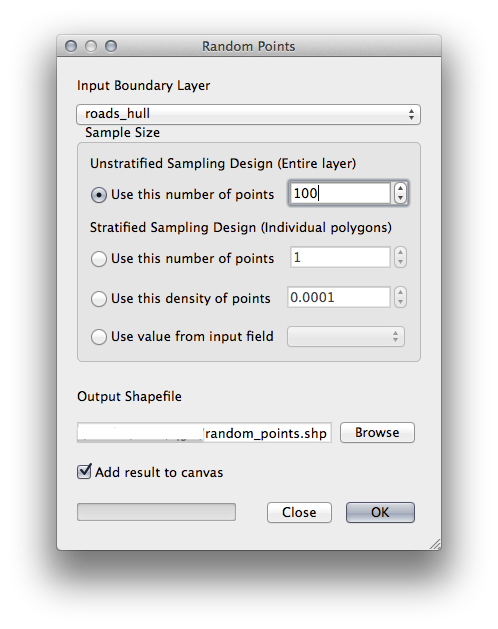
- Save the output under exercise_data/spatial_statistics/ as random_points.shp.
- Check Add result to canvas option to add the output to the TOC (Layers list).

7.4.1.2. Muestreo de los datos¶
- To create a sample dataset from the raster, you’ll need to use the Point sampling tool plugin.
- Refer ahead to the module on plugins if necessary.
- Search for the phrase point sampling in the Plugin ‣ Manage and Install Plugins... and you will find the plugin.
- As soon as it has been activated with the Plugin Manager, you will find the tool under Plugins ‣ Analyses ‣ Point sampling tool:
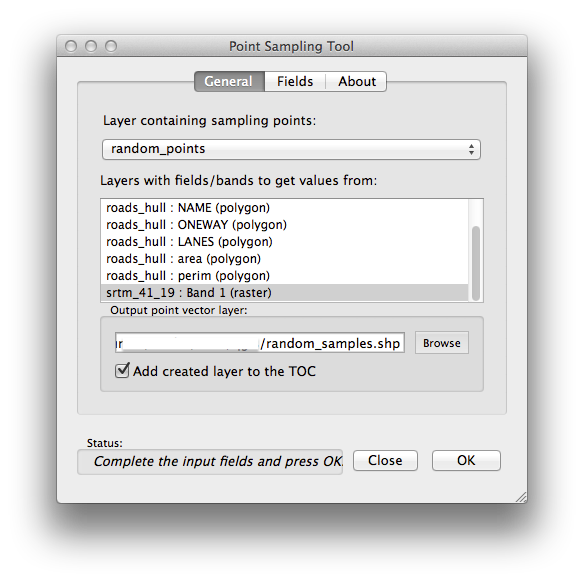
- Select random_points as the layer containing sampling points, and the SRTM raster as the band to get values from.
- Make sure that “Add created layer to the TOC” is checked.
- Save the output under exercise_data/spatial_statistics/ as random_samples.shp.
Now you can check the sampled data from the raster file in the attributes table of the random_samples layer, they will be in a column named srtm_41_19.tif.
Aquí tienes una posible capa de muestreo:
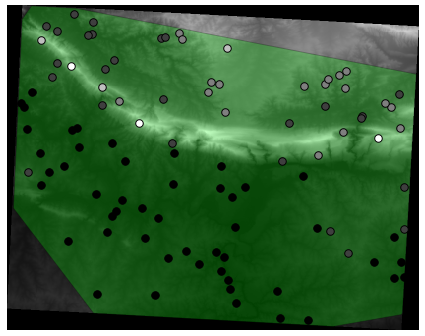
The sample points are classified by their value such that darker points are at a lower altitude.
Utilizarás esta capa de datos de muestreo durante el resto de los ejercicios estadísticos.
7.4.2.  Follow Along: Estadísticas Básicas¶
Follow Along: Estadísticas Básicas¶
Ahora obtén lsa estadísticas básica de esta capa.
- Click on the Vector ‣ Analysis Tools ‣ Basic statistics menu entry.
- In the dialog that appears, specify the random_samples layer as the source.
- Make sure that the Target field is set to srtm_41_19.tif which is the field you will calculate statistics for.
- Click OK. You’ll get results like this:

Nota
You can copy and paste the results into a spreadsheet. The data uses a (colon :) separator.
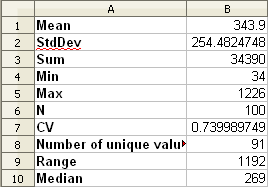
- Close the plugin dialog when done.
To understand the statistics above, refer to this definition list:
- Media
La media (promedio) es simplemente la suma de los valores dividido por el número de valores.
- StdDev
La desviación estándar. Da una indicación de cómo de cerca se agrupan los valores alrededor de la media. Cuanto menor sea la desviación estándar, más cerca estarán los valores a la media.
- Suma
Todos los valores sumados.
- Min
El valor mínimo
- Max
El valor máximo.
- N
Número de muestras/valores.
- CV
- The spatial covariance of the dataset.
- Number of unique values
- The number of values that are unique across this dataset. If there are 90 unique values in a dataset with N=100, then the 10 remaining values are the same as one or more of each other.
- Intervalo
La diferencia entre los valores mínimo y máximo.
- Mediana
Si organizas todos los valores de menor a mayor, el valor en el medio (o la media de los dos valores en el medio, si N es un número par) es la mediana de los valores.
7.4.3.  Follow Along: Compute a Distance Matrix¶
Follow Along: Compute a Distance Matrix¶
- Create a new point layer in the same projection as the other datasets (WGS 84 / UTM 34S).
- Enter edit mode and digitize three point somewhere among the other points.
- Alternatively, use the same random point generation method as before, but specify only three points.
- Save your new layer as distance_points.shp.
To generate a distance matrix using these points:
- Open the tool Vector ‣ Analysis Tools ‣ Distance matrix.
- Select the distance_points layer as the input layer, and the random_samples layer as the target layer.
Ajústalo así:
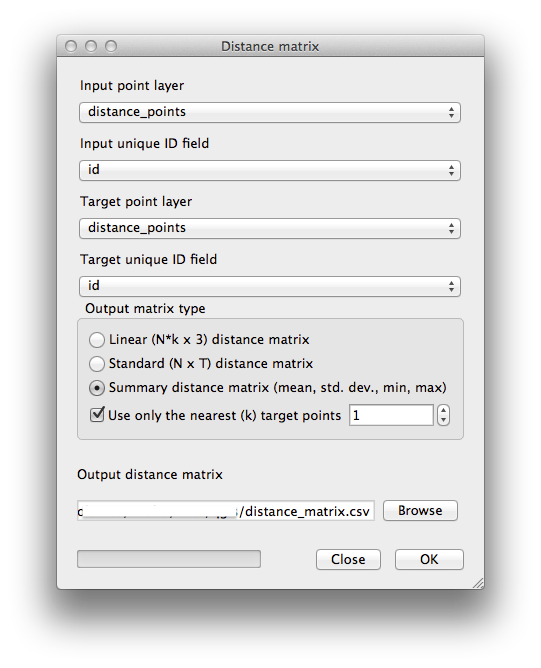
- Save the result as distance_matrix.csv.
- Click OK to generate the distance matrix.
- Open it in a spreadsheet program to see the results. Here is an example:

7.4.4.  Follow Along: Nearest Neighbor Analysis¶
Follow Along: Nearest Neighbor Analysis¶
To do a nearest neighbor analysis:
- Click on the menu item Vector ‣ Analysis Tools ‣ Nearest neighbor analysis.
- In the dialog that appears, select the random_samples layer and click OK.
- The results will appear in the dialog’s text window, for example:

Nota
You can copy and paste the results into a spreadsheet. The data uses a (colon :) separator.
7.4.5.  Follow Along: Coordenadas Medias¶
Follow Along: Coordenadas Medias¶
Para obtener las coordenadas medias de un conjunto de datos:
- Click on the Vector ‣ Analysis Tools ‣ Mean coordinate(s) menu item.
- In the dialog that appears, specify random_samples as the input layer, but leave the optional choices unchanged.
- Specify the output layer as mean_coords.shp.
- Click OK.
- Add the layer to the Layers list when prompted.
Compara estas con la coordenada central del polígono que fue utilizada para crear la muestra aleatoria.
- Click on the Vector ‣ Geometry Tools ‣ Polygon centroids menu item.
- In the dialog that appears, select roads_hull as the input layer.
- Save the result as center_point.
- Add it to the Layers list when prompted.
As you can see from the example below, the mean coordinates and the center of the study area (in orange) don’t necessarily coincide:

7.4.6.  Follow Along: Histogramas de Imagenes¶
Follow Along: Histogramas de Imagenes¶
The histogram of a dataset shows the distribution of its values. The simplest way to demonstrate this in QGIS is via the image histogram, available in the Layer Properties dialog of any image layer.
- In your Layers list, right-click on the SRTM DEM layer.
Selecciona Propiedades.
Elige la pestaña Histograma. Puede que necesites clicar en el botón Calcular Histograma para generar un gráfico. Verás un gráfico describiendo la frecuencia de los valores en la imagen.
Puedes exportarlo como una imagen:

- Select the Metadata tab, you can see more detailed information inside the Properties box.
The mean value is 332.8, and the maximum value is 1699! But those values don’t show up on the histogram. Why not? It’s because there are so few of them, compared to the abundance of pixels with values below the mean. That’s also why the histogram extends so far to the right, even though there is no visible red line marking the frequency of values higher than about 250.
Además, ten presente que el histograma te muestra la distribución de los valores, y no todos los valores son necesariamente visibles en el gráfico.
- (You may now close Layer Properties.)
7.4.7.  Follow Along: Interpolación Espacial¶
Follow Along: Interpolación Espacial¶
Let’s say you have a collection of sample points from which you would like to extrapolate data. For example, you might have access to the random_samples dataset we created earlier, and would like to have some idea of what the terrain looks like.
To start, launch the Grid (Interpolation) tool by clicking on the Raster ‣ Analysis ‣ Grid (Interpolation) menu item.
- In the Input file field, select random_samples.
- Check the Z Field box, and select the field srtm_41_19.
- Set the Output file location to exercise_data/spatial_statistics/interpolation.tif.
- Check the Algorithm box and select Inverse distance to a power.
- Set the Power to 5.0 and the Smoothing to 2.0. Leave the other values as-is.
- Check the Load into canvas when finished box and click OK.
- When it’s done, click OK on the dialog that says Process completed, click OK on the dialog showing feedback information (if it has appeared), and click Close on the Grid (Interpolation) dialog.
Aquí se compara el conjunto de datos original (izquierda) y el construido por nuestros puntos de muestreo (derecha). El tuyo puede parecer diferente debido a la forma aleatoria de situación y puntos de muestreo.

As you can see, 100 sample points aren’t really enough to get a detailed impression of the terrain. It gives a very general idea, but it can be misleading as well. For example, in the image above, it is not clear that there is a high, unbroken mountain running from east to west; rather, the image seems to show a valley, with high peaks to the west. Just using visual inspection, we can see that the sample dataset is not representative of the terrain.
7.4.8.  Try Yourself¶
Try Yourself¶
- Use the processes shown above to create a new set of 1000 random points.
Utiliza los puntos para muestrear el DEM original.
- Use the Grid (Interpolation) tool on this new dataset as above.
- Set the output filename to interpolation_1000.tif, with Power and Smoothing set to 5.0 and 2.0, respectively.
Los resultados (dependiendo de la posición de tus puntos aleatorios) se verán más o menos como esto:

The border shows the roads_hull layer (which represents the boundary of the random sample points) to explain the sudden lack of detail beyond its edges. This is a much better representation of the terrain, due to the much greater density of sample points.
Here is an example of what it looks like with 10 000 sample points:

Nota
It’s not recommended that you try doing this with 10 000 sample points if you are not working on a fast computer, as the size of the sample dataset requires a lot of processing time.
7.4.9.  Follow Along: Additional Spatial Analysis Tools¶
Follow Along: Additional Spatial Analysis Tools¶
Originally a separate project and then accessible as a plugin, the SEXTANTE software has been added to QGIS as a core function from version 2.0. You can find it as a new QGIS menu with its new name Processing from where you can access a rich toolbox of spatial analysis tools allows you to access various plugin tools from within a single interface.
- Activate this set of tools by enabling the Processing ‣ Toolbox menu entry. The toolbox looks like this:

You will probably see it docked in QGIS to the right of the map. Note that the tools listed here are links to the actual tools. Some of them are SEXTANTE’s own algorithms and others are links to tools that are accessed from external applications such as GRASS, SAGA or the Orfeo Toolbox. This external applications are installed with QGIS so you are already able to make use of them. In case you need to change the configuration of the Processing tools or, for example, you need to update to a new version of one of the external applications, you can access its setting from Processing ‣ Options and configurations.
7.4.10.  Follow Along: Spatial Point Pattern Analysis¶
Follow Along: Spatial Point Pattern Analysis¶
For a simple indication of the spatial distribution of points in the random_samples dataset, we can make use of SAGA’s Spatial Point Pattern Analysis tool via the Processing Toolbox you just opened.
- In the Processing Toolbox, search for this tool Spatial Point Pattern Analysis.
- Double-click on it to open its dialog.
7.4.10.1. Installing SAGA¶
Nota
If SAGA is not installed on your system, the plugin’s dialog will inform you that the dependency is missing. If this is not the case, you can skip these steps.
7.4.10.2. On Windows¶
Included in your course materials you will find the SAGA installer for Windows.
- Start the program and follow its instructions to install SAGA on your Windows system. Take note of the path you are installing it under!
Once you have installed SAGA, you’ll need to configure SEXTANTE to find the path it was installed under.
- Click on the menu entry Analysis ‣ SAGA options and configuration.
- In the dialog that appears, expand the SAGA item and look for SAGA folder. Its value will be blank.
- In this space, insert the path where you installed SAGA.
7.4.10.3. On Ubuntu¶
- Search for SAGA GIS in the Software Center, or enter the phrase sudo apt-get install saga-gis in your terminal. (You may first need to add a SAGA repository to your sources.)
- QGIS will find SAGA automatically, although you may need to restart QGIS if it doesn’t work straight away.
7.4.10.4. On Mac¶
Homebrew users can install SAGA with this command:
- brew install saga-core
If you do not use Homebrew, please follow the instructions here:
http://sourceforge.net/apps/trac/saga-gis/wiki/Compiling%20SAGA%20on%20Mac%20OS%20X
7.4.10.5. After installing¶
Now that you have installed and configured SAGA, its functions will become accessible to you.
7.4.10.6. Using SAGA¶
- Open the SAGA dialog.
- SAGA produces three outputs, and so will require three output paths.
- Save these three outputs under exercise_data/spatial_statistics/, using whatever file names you find appropriate.

The output will look like this (the symbology was changed for this example):

The red dot is the mean center; the large circle is the standard distance, which gives an indication of how closely the points are distributed around the mean center; and the rectangle is the bounding box, describing the smallest possible rectangle which will still enclose all the points.
7.4.11.  Follow Along: Minimum Distance Analysis¶
Follow Along: Minimum Distance Analysis¶
Often, the output of an algorithm will not be a shapefile, but rather a table summarizing the statistical properties of a dataset. One of these is the Minimum Distance Analysis tool.
- Find this tool in the Processing Toolbox as Minimum Distance Analysis.
It does not require any other input besides specifying the vector point dataset to be analyzed.
- Choose the random_points dataset.
- Click OK. On completion, a DBF table will appear in the Layers list.
- Select it, then open its attribute table. Although the figures may vary, your results will be in this format:

7.4.12. In Conclusion¶
QGIS permite muchas posibilidades para analizar las propiedades espaciales estadísticas de conjuntos de datos.
7.4.13. What’s Next?¶
Ahora que has cubierto los análisis vectoriales, ¿Por qué no ver qué se puede hacer con rasters? ¡Eso es lo que haremos en el próximo módulo!